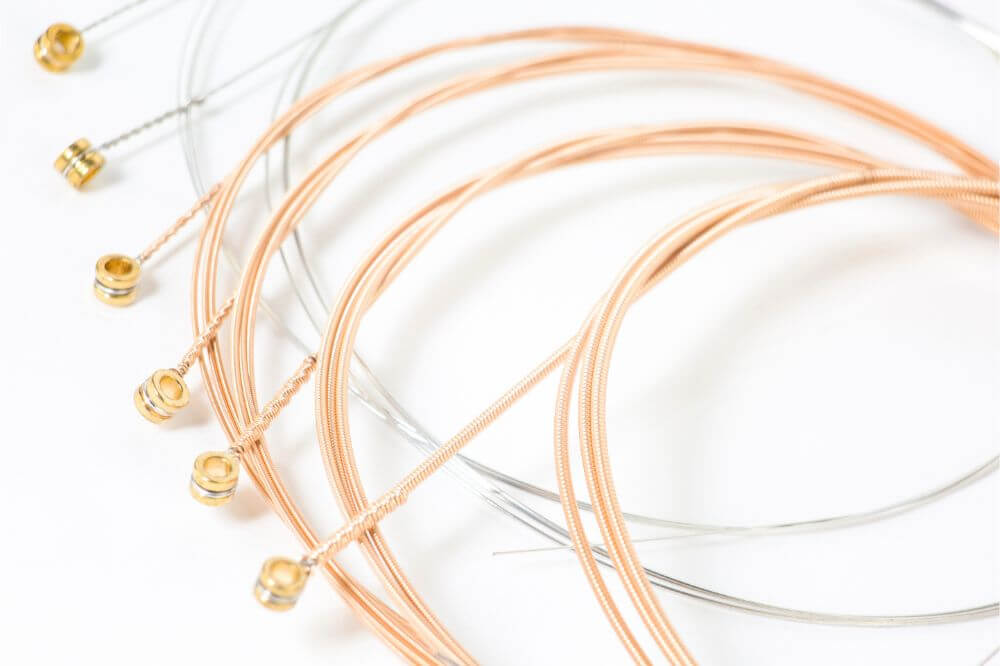When choosing a string for your guitar, it’s crucial to understand the different types of strings and materials. Each type of guitar string responds uniquely and has a different feeling underneath your fingertips.
The correct string can also be a great asset to you while playing, just as the wrong string can be a massive hindrance. This article will go over the different types of guitar strings and how to best choose the correct string for your guitar. So let’s take a look at everything you need to know to get you started.
The Basics of Guitar Strings
Different types of guitars have a different number of strings. Most guitars will have six strings, though you will often find that some guitars have seven or eight strings while others have up to twelve strings.
Your primary, everyday guitar is only going to have six strings. These strings are an essential part of playing your guitar. There are a few critical things about your strings that you should know before you start playing.
Gauges
The ‘string gauge’ refers to the diameter of your string. When you look at the packaging of a string gauge, understand that it is measured in 1/1000th of an inch—the lower the gauge, the lighter the stringer.
Guitar strings come in a wide variety of gauges. The different gauges can be used to determine the sound and tone of the guitar. The lighter the gauge usually means for a beginner, the easier it is to play. However, a lighter string may not be able to sustain new techniques, like vibrato.
A medium gauge is best for intermediate players who are looking for stability. These heavier gauges provide just the right amount of push-back against the fingers and allow for better control.
Finally, a heavy gauge guitar string is well-favored by expert guitarists and those who play punk, rock, and heavy metal. A heavy gauge gives the guitar a more complex sound, which can be great for those looking for a little bit of oomph to their sound.
Core
When discussing the core of a guitar string, core means the shape of the wire inside the plated casing. There are two main shapes of guitar string core: round core and hex core.
Hex core strings offer a louder and brighter sound. These strings sound a lot more ‘modern’ than the round core. Rock and metal guitarists often use strings with a hex core. When playing, these individual cores also have a more stiff feel, giving you a little more control and something to push against.
Meanwhile, round core strings have a more relaxed and mellow tone, something you might hear with classic rock. These cores are slightly softer, making them great for beginners who are just starting to figure out how to control their strings.
Type of String Material
When getting the right guitar strings, you have to look at the strings’ material. There are five main types of materials: brass and bronze, steel and nickel, and nylon. Each of these five types has its purpose and can significantly alter the sound and feel of your playing.
Brass and Bronze
Brass and bronze are the two primary materials for the string used in a steel-string acoustic guitar. While the wires are made from steel, they’re platted in either brass or bronze, hence the name.
Brass strings, usually made from 80% copper and 20% zinc (earning the nickname 80/20), have a bright and defined sound. Meanwhile, bronze strings are more smooth and warm, making them the perfect string for a more relaxed playing style.
Because an acoustic guitar resonates without using an amp or stereo, the strings used here are best for resonating and amplifying the sound.

Steel and Nickel
Most electric guitars use steel and nickel guitar strings. Usually, the thickest strings on the electric guitar are plated in nickel. However, more and more manufacturers are stringing their electric guitars with all steel or all nickel strings in recent years.
These two materials give off vastly different sounds. Steel has a brighter sound with a higher tone. Meanwhile, nickel strings are much richer tones. If you have nickel-plated steel strings, you get the best of both worlds, with a lot of body to the sound and a rich tone.
Steel and nickel are best for electric guitars because of how sturdy they are. They can sustain heavy picking and experimental styles without breaking down as easily as some of the other strings.
Nylon
Finally, nylon strings are used for classical guitars. Your guitar will have a very warm and mellow tone with nylon strings. This is the perfect sound for classical guitars. Steel strings should never be used on a classical guitar, as classical guitars are built differently than acoustic or electric guitars.
Nylon strings have a lot less resonance than steel or brass strings. They also have a lot less versatility. While they’re great for beginners, if you’re looking to experiment with tone, style, or genre, you’ll want to look at acoustic guitars with hardier strings.
Frequently Asked Questions
When should I change my guitar strings?
When you’re new to playing guitar, it’ll take you a while to get a feel for when your strings need to be changed. As a general rule of thumb, if you’re having trouble getting and keeping your guitar in tune, you should consider a string change.
You should also change your guitar strings if your tone sounds flat or if the plating on your strings is coming undone or showing any discoloration or rust. If you’ve been playing on your strings since you got your guitar and wonder if you should change them, the answer is probably yes.
How long do guitar strings last?
The life of a guitar string can vary from person to person. If you don’t play your guitar often but keep it clean and take care of it, your strings will last you quite a while. However, if you play aggressively every day, change your tuning, or keep your guitar in an unsafe environment, you’re more likely to change your guitar strings more frequently.
How do I keep my guitar strings healthy?
Wipe down your guitar after every session, and try to play with clean hands. Sweat on your hands can significantly shorten the length of your guitar strings due to the acidity in your sweat and the oils on your hands.
Try to wash your hands before any extensive playing. This can help prevent your strings from rusting or breaking down as fast from the oils or sweat on your hands.
Conclusion
Learning about your guitar strings can help you better understand how to take care of your guitar as you learn to play. There are many varying types of strings with different gauges, cores, and finishes. Each of these unique strings will give your guitar its own sound and will come down to your preference.
The string that you choose can also significantly affect how you play. The string type can help set the tone of the genre you’re looking to invoke. Keeping your guitar strings healthy will extend the life of the strings, so you won’t have to change them as often.




















